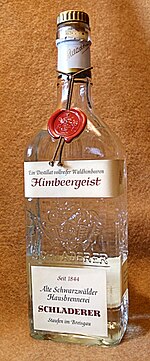Himbeergeist

Himbeergeist(lit"raspberryspirit",also known asraspberry spirit obtained by maceration and distillation,[1]eau de vie de framboise[2]or simplyframboise[3]) is ageist(a type ofeau de vieorSchnapps) made from raspberries. It is produced mainly inGermanyand theAlsaceregion of France.
Rather distilling afermentedmash of fresh fruit intoliquor,like afruit brandy(Obstlerin German),Himbeergeistis made as aninfusion.[4]Raspberries have a low sugar content that can only produce a limited amount of alcohol, soHimbeergeistis created bymaceratingfresh berries in 96% pureneutral spirits.[5][6]The mixture is then steeped for several weeks to draw out the raspberry essence,distilled,diluted with purified water, and bottled at 37.5%ABVor stronger. Producers may add a small amount of sugar to round off the final taste, but under EU law, this cannot exceed 10 grams of invert sugar per litre. Added colours and flavours are also not permitted.[1]
It takes about 17 pounds (7.7 kg) of raspberries to produce one liter ofHimbeergeist.[7]
See also[edit]
References[edit]
- ^ab"Consolidated text: Regulation (EU) 2019/787 of the European Parliament and of the Council of 17 April 2019 on the definition, description, presentation and labelling of spirit drinks, the use of the names of spirit drinks in the presentation and labelling of other foodstuffs, the protection of geographical indications for spirit drinks, the use of ethyl alcohol and distillates of agricultural origin in alcoholic beverages, and repealing Regulation (EC) No 110/2008".25 May 2021. pp. 49–51.
- ^Anderson, Susan Heller (26 August 1984)."Alsace's Eaux de Vie Pack a Fruity Punch".The New York Times.
- ^Asimov, Eric (15 August 2007)."An Orchard in a Bottle, at 80 Proof".The New York Times.
- ^Regulation (EU) No 110/2008 of 15 January 2008 on the definition, description, presentation, labelling and the protection of geographical indications of spirit drinks and repealing Council Regulation (EEC) No 1576/89§17
- ^"Spirituosenlexikon".Die Schnapsbrenner(in German). Archived fromthe originalon 10 April 2008.
- ^"Fachlexikon".hoellberg.de(in German). Archived fromthe originalon 9 October 2007.
- ^Virbila, S. Irene (22 April 1990)."Eau-de-Vie, the Spirit of Alsace".The New York Times.Retrieved21 November2021.
